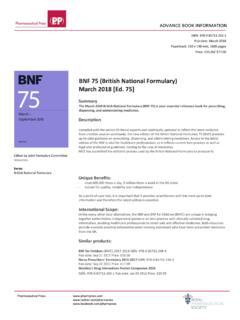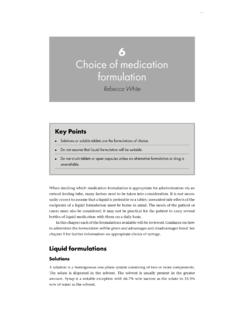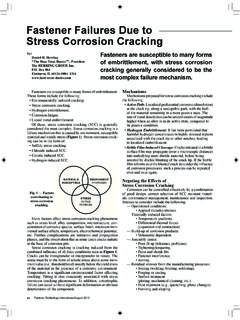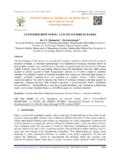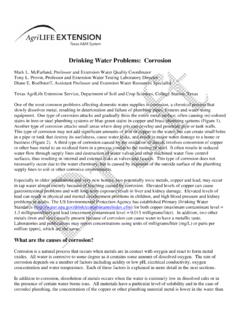Transcription of Basic Pharmacokinetics Sample Chapter
1 666 Extravascular routes of Drug remaining to be absorbed, or drugremaining at the site of Determination of elimination half life(t1/2) and elimination rate constant (KorKel) Absorption rate constant (Ka) Wagner Nelson method(one-compartment model) andLoo Riegelman method(two-compartment model) Lag time (t0) Some important comments on theabsorption rate The apparent volume of distribution (V) Time of maximum drug concentration,peak time (tmax) Maximum (peak) plasma concentration(Cp) Some general Example for extravascular route of Flip-flop kinetics126 ObjectivesUpon completion of this Chapter , you will have the ability to.
2 Calculate plasma drug concentration at any given time after the administration of an extravasculardose of a drug, based on known or estimated pharmacokinetic parameters interpret the plasma drug concentration versus time curve of a drug administered extravascularlyas the sum of an absorption curve and an elimination curve employ extrapolation techniques to characterize the absorption phase calculate the absorption rate constant and explain factors that influence this constant explain possible reasons for the presence oflag timein a drug s absorption calculate peak plasma drug concentration,(Cp)max, and the time,tmax, at which this occurs explain the factors that influence peak plasma concentration and peak time decide when flip-flop kinetics may be a factor in the plasma drug concentration versus time curveof a drug administered Chapter forBasic Pharmacokinetics 2nd editionCopyright Pharmaceutical Press IntroductionDrugs, through dosage forms, are most frequentlyadministered extravascularly and the majority of themare intended to act systemically; for this reason,absorption is a prerequisite for pharmacologicaleffects.
3 Delays or drug loss during absorption maycontribute to variability in drug response and, occa-sionally, may result in a failure of drug gastrointestinal membrane separates the ab-sorption site from the blood. Therefore, passage ofdrug across the membrane is a prerequisite for ab-sorption. For this reason, drug must be in a solutionform and dissolution becomes very critical for theabsorption of a drug. The passage of drug moleculesfrom the gastrointestinal tract to the general circula-tion and factors affecting this are shown in Figs Any factor influencing dissolution of thedrug is likely to affect the absorption of a drug.
4 Thesefactors will be discussed, in detail, later in the , once in solution, must pass through mem-branes before reaching the general circulation. Hence,the physicochemical properties of the drug molecule(pKaof the drug, partition coefficient of the drug, drugsolubility, etc.), pH at the site of drug administration,nature of the membrane, and physiological factorswill also influence the absorption of a present discussion will deal with general prin-ciples that determine the rate and extent of drugabsorption and the methods used to assess theseand other pharmacokinetic parameters, from plasmaconcentration versus time data following oral admin-istration of drugs.
5 Emphasis is placed upon absorp-tion of drugs following oral administration because itillustrates all sources of variability encounteredduring drug that a similar approach may be applied todetermine pharmacokinetic parameters of drugs whenany other extravascular route is following assumptions are made. Drug exhibits the characteristics of one-compartment model. Absorption and elimination of a drug followthe first-order process and passive diffusion isoperative all the time. Drug is eliminated in unchanged form ( , nometabolism occurs). Drug is monitored in the pharmacokinetic parametersFigure outlines the absorption of a drug that fits aone-compartment model with first-order following information is useful.
6 1equation for determining the plasma concentra-tion at any timet2determination of the elimination half life (t1/2)and rate constant (KorKel)3determination of the absorption half life(t1/2)absand absorption rate constant (Ka)4lag time (t0), if any5determination of the apparent volume of distri-bution (VorVd) and fraction of drug absorbed(F)6determination of the peak time (tmax)7determination of the peak plasma or serum con-centration(Cp) Drug remaining to beabsorbed, or drug remaining atthe site of administrationEquation ( ) describes the changes in mass of ab-sorbable drug over time at the site of administration. dXadt=Ka(Xa)t( )where dX/dtis the decrease in the amount of ab-sorbable drug present at the site of administration perunit time ( ,mg h 1);Kais the first-order absorp-tion rate constant (h 1;min 1); and(Xa)tis the massor amount of absorbable drug at the site of adminis-tration ( , the gastrointestinal tract) at integration of Eq.
7 ( ), we obtain the fol-lowing:(Xa)t=(Xa)t=0e Kat=FX0e Kat( )where(Xa)t=0is the mass or amount of absorbabledrug at the site of administration at timet=0(forextravascular administration of drug,(Xa)t=0equalsFX0);Fis the fraction or percentage of the ad-ministered dose that is available to reach the gen-eral circulation; andX0is the administered dose , that is, if the drug is completely(100%) absorbed, then(Xa)t=X0e Kat.( ) Sample Chapter forBasic Pharmacokinetics 2nd editionCopyright Pharmaceutical Press routes of drug administration107 Figure to gastrointestinal Eqs ( ) and ( ) and Fig. clearly indi-cate that the mass, or amount, of drug that remainsat the absorption site or site of administration (orremains to be absorbed) declines monoexponentiallywith , since we cannot measure the amountof drug remaining to be absorbed (Xa) directly, be-cause of practical difficulty, Eqs ( ) and ( ), forthe time being, become virtually useless for the pur-pose of determining the absorption rate constant.
8 And, therefore, we go to other alternatives such asmonitoring drug in the blood and/or urine to deter-mine the absorption rate constant and the drug in the blood(plasma/serum) or site of measurementThe differential equation that follows relates changesin drug concentration in the blood with time to theabsorption and the elimination rates:dXdt=KaXa KX( )wheredX/dtisthe rate (mg h 1) of change of amountof drug in the blood;Xis the mass or amount ofdrug in the blood or body at timet;Xais the massor amount of absorbable drug at the absorption siteat timet;KaandKare the first-order absorption andelimination rate constants, respectively ( ,h 1);KaXais the first-order rate of absorption (mg h 1, g h 1, etc.)
9 ; andKXis the first-order rate of elim-ination ( ,mg h 1).Equation ( ) clearly indicates that rate ofchange in drug in the blood reflects the differencebetween the absorption and the elimination rates ( ,KaXaandKX, respectively). Following the adminis-tration of a dose of drug, the difference between theabsorption and elimination rates ( ,KaXa KX)becomes smaller as time increases; at peak time, thedifference becomes Chapter forBasic Pharmacokinetics 2nd editionCopyright Pharmaceutical Press PharmacokineticsFigure of drug in the gastrointestinal tract until transport across the :SETUP:XaXX(drug in body orblood) K (h 1)EliminationXuXuKKaKa (h 1)AbsorptionXa(Absorbabledrug at absorptionsite) Figure of a one-compartment drug with first-order elimination, whereXais the mass or amount of absorbabledrug remaining in the gut, or at the site of administration, at timet( , drug available for absorption at timet);Xis the mass oramount of drug in the blood at timet;Xuis the mass or amount of drug excreted unchanged in the urine at timet.
10 Kais thefirst-order absorption rate constant (h 1or min 1); andK(orKel) is the first-order elimination rate constant (h 1or min 1). Sample Chapter forBasic Pharmacokinetics 2nd editionCopyright Pharmaceutical Press routes of drug administration109 Time (h)t = 0Xa (mg)Intercept = (Xa)0 or FX0 Slope = (h)t = 0Xa (mg)(a)(b)Figure of drug remaining at the site of administration against time in a rectilinear plot (a) and a semilogarithmicplot (b).Xa, amount of absorbable drug at the site of administration;(Xa)0, amount of absorbable drug at the site ofadministration at timet=0;F, fraction of administered dose that is available to reach the general that, most of the time, the absorptionrate constant is greater than the elimination rate con-stant.



